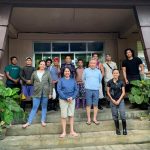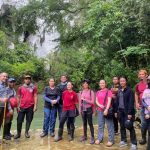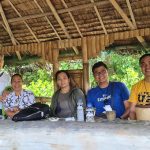The UST Graduate School – Center for Conservation of Cultural Property and Environment in the Tropics (USTGS-CCCPET) and the College of Tourism and Hospitality Management (CTHM) conducted a two-week Tourist Site/Attraction Evaluation from October 25 to November 7, 2021 at the Samar Island Natural Park (SINP).
The project’s objective is to conceptualize a sustainable tourism and strategic development plan for SINP using the stakeholders’ participation and perspective and statement of natural heritage significance approaches. It is associated with the preliminary requirements for the nomination bid in the United Nations Educational, Scientific and Cultural Organization (UNESCO) World Natural Heritage Site.
The team assessed 14 SINP ecotourism sites and one associated site within the Samar Island area. The sites were: Lulugayan Falls and River and Langun-Gobingob Cave in Calbiga, Sohoton Cave and Natural Bridge in Basey, La Milagrosa Falls in Pinabacdao, Ulot Watershed in Paranas, Pinipisakan Falls and Sulpan Cave in San Jorge, Mt. Huraw in San Jose de Buan, Paglantuyan Falls in Motiong, Lobo Cave in Jiabong, Pinipisakan Falls in Las Navas, Northern Samar, Taft Forest Philippine Eagle Sanctuary, Maharlika Falls in Taft, Bulusao Watershed and Forest Reserve (Amandaraga Falls) in Lawaan, and Borongan (Maydolong Balangkayan) Llorente Closed Canopy Forest in Eastern Samar.
The UNESCO SINP Nomination Team is headed by CCCPET Director Assoc. Prof. Eric B. Zerrudo, Ph.D., with the Project Coordinator, Ms. Beverly M. Bautista. Under the UST Tourism Team are: Jame Monren T. Mercado (Team Leader), CTHM Dean Assoc. Prof. Atty. Gezzez Giezi G. Granado, D.C.L., (Team Member), and Mr. Avi Ben P. Andalecio (Team Member).
The project was initiated by the Office of Congresswoman Sharee Ann Tan, An Waray Partylist, Provincial Governments of Samar, Northern Samar, and Eastern Samar, the Department of Tourism (DOT) Region VIII, and the Department of Environment and Natural Resources – Protected Areas Management Bureau (DENR PAMB) Region VIII.
Earlier this year, the CCCPET and the UST College of Science – Department of Biological Sciences, in collaboration with the aforementioned offices, conducted field surveys in target sites around SINP from October 22 to November 12, 2021.
The 333,330-hectare SINP is the largest known protected area on the island and straddles the provinces of Northern Samar, Eastern Samar, and Samar.
This project aims to provide a comprehensive inventory and assessment of the diversity of the flora and fauna in SINP. The output of this project will provide crucial biodiversity information to support its nomination as a UNESCO World Heritage Site.
The field expedition team was basically divided into two and each had members who are known specialists on certain taxonomic groups of plants and animals. The Flora team was headed by project leaders from the College of Science, Prof. Cecilia B. Moran and Mr. Jorge Anton Ordas, and was assisted by a research assistant and 12 field assistants.
The Fauna team was headed by Asst. Prof. Mae Lowe L. Diesmos from the College of Science and Asst. Prof. Mariano Roy Duya from the University of the Philippines Diliman along with two research assistants and six field assistants.
The composite team was composed of faculty members and graduate students from UST, UP Diliman, UP Los Baños, and the University of San Carlos.
Consultants included Dr. Juan Carlos T. Gonzales and Ms. Carme Irene Pelone (for birds), Dr. Arvin C. Diesmos (for amphibians), Mr. Yñigo del Pardo (for reptiles), and Dr. Grecebio Jonathan D. Alejandro and Mr. Danilo N. Tandang (for plants).
These specialists will analyze data from the expedition including information from previous field studies, to provide a comprehensive science-based synopsis that will strengthen the SINP dossier for nomination to the UNESCO World Heritage Sites.







